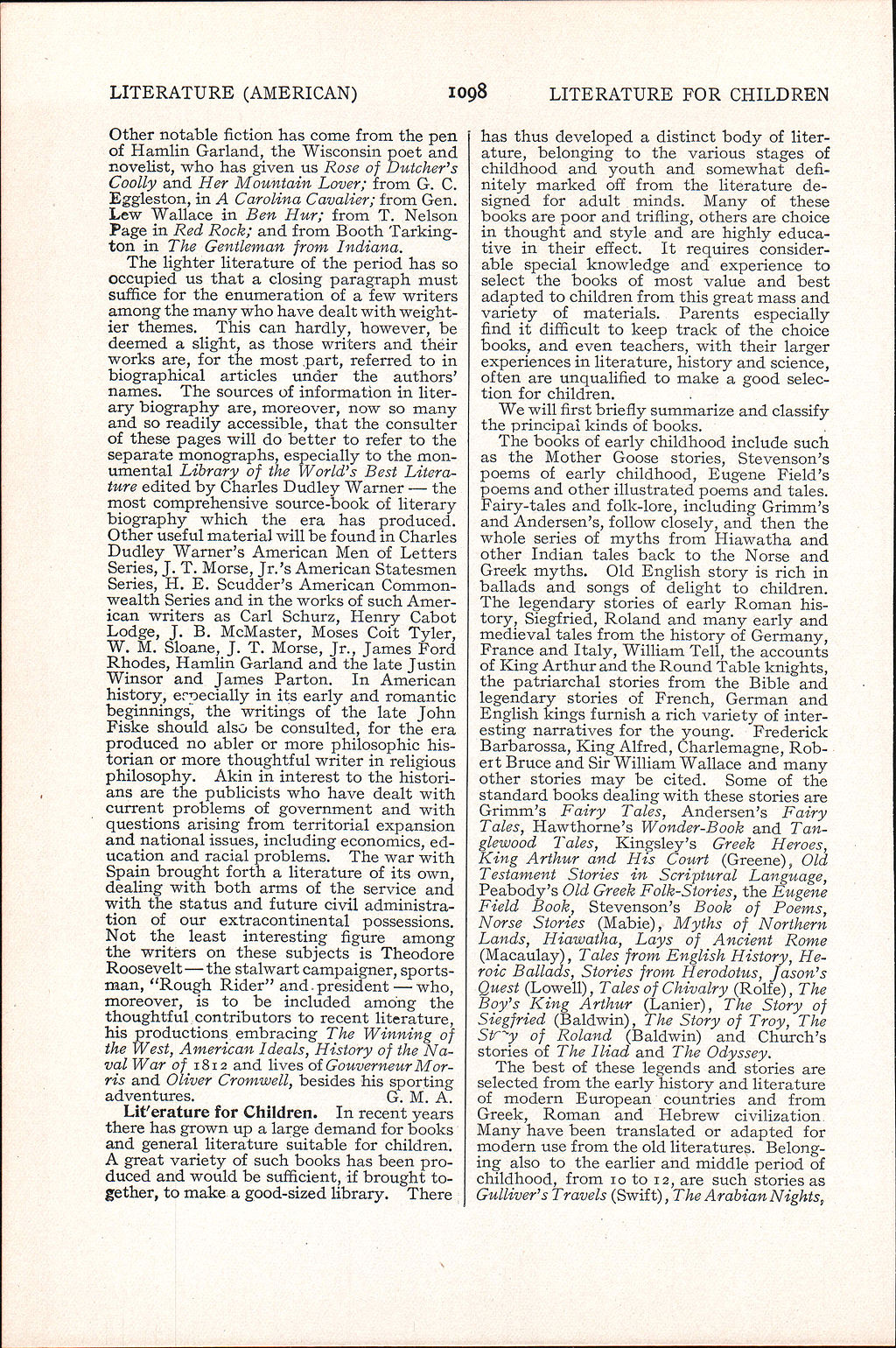Other notable fiction has come from the pen of Hamlin Garland, the Wisconsin poet and novelist, who has given us Rose of Dutcher's Coolly and Her Mountain Lover; from G. C. Eggleston, in A Carolina Cavalier; from Gen. Lew Wallace in Ben Hur; from T. Nelson Page in Red Rock; and from Booth Tarkington in The Gentleman from Indiana.
The lighter literature of the period has so occupied us that a closing paragraph must suffice for the enumeration of a few writers among the many who have dealt with weightier themes. This can hardly, however, be deemed a slight, as those writers and their works are, for the most part, referred to in biographical articles under the authors' names. The sources of information in literary biography are, moreover, now so many and so readily accessible, that the consulter of these pages will do better to refer to the separate monographs, especially to the monumental Library of the World's Best Literature edited by Charles Dudley Warner — the most comprehensive source-book of literary biography which the era has produced. Other useful material will be found in Charles Dudley Warner's American Men of Letters Series, J. T. Morse, Jr's American Statesmen Series, H. E. Scudder's American Commonwealth Series and in the works of such American writers as Carl Schurz, Henry Cabot Lodge, J. B. McMaster, Moses Coit Tyler, W. M. Sloane, J. T. Morse, Jr., James Ford Rhodes, Hamlin Garland and the late Justin Winsor and James Parton. In American history, especially in its early and romantic beginnings, the writings of the late John Fiske should also be consulted, for the era produced no abler or more philosophic historian or more thoughtful writer in religious philosophy. Akin in interest to the historians are the publicists who have dealt with current problems of government and with questions arising from territorial expansion and national issues, including economics, education and racial problems. The war with Spain brought forth a literature of its own, dealing with both arms of the service and with the status and future civil administration of our extracontinental possessions. Not the least interesting figure among the writers on these subjects is Theodore Roosevelt — the stalwart campaigner, sportsman, “Rough Rider” and president — who, moreover, is to be included among the thoughtful contributors to recent literature, his productions embracing The Winning of the West, American Ideals, History of the Naval War of 1812 and lives of Gouverneur Morris and Oliver Cromwell, besides his sporting adventures. G. M. A.
Lit′erature for Children. In recent years there has grown up a large demand for books and general literature suitable for children. A great variety of such books has been produced and would be sufficient, if brought together, to make a good-sized library. There has thus developed a distinct body of literature, belonging to the various stages of childhood and youth and somewhat definitely marked off from the literature designed for adult minds. Many of these books are poor and trifling, others are choice in thought and style and are highly educative in their effect. It requires considerable special knowledge and experience to select the books of most value and best adapted to children from this great mass and variety of materials. Parents especially find it difficult to keep track of the choice books, and even teachers, with their larger experiences in literature, history and science, often are unqualified to make a good selection for children.
We will first briefly summarize and classify the principal kinds of books.
The books of early childhood include such as the Mother Goose stories, Stevenson's poems of early childhood, Eugene Field's poems and other illustrated poems and tales. Fairy-tales and folk-lore, including Grimm's and Andersen's, follow closely, and then the whole series of myths from Hiawatha and other Indian tales back to the Norse and Greek myths. Old English story is rich in ballads and songs of delight to children. The legendary stories of early Roman history, Siegfried, Roland and many early and medieval tales from the history of Germany, France and Italy, William Tell, the accounts of King Arthur and the Round Table knights, the patriarchal stories from the Bible and legendary stories of French, German and English kings furnish a rich variety of interesting narratives for the young. Frederick Barbarossa, King Alfred, Charlemagne, Robert Bruce and Sir William Wallace and many other stories may be cited. Some of the standard books dealing with these stories are Grimm's Fairy Tales, Andersen's Fairy Tales, Hawthorne's Wonder-Book and Tanglewood Tales, Kingsley's Greek Heroes, King Arthur and His Court (Greene), Old Testament Stories in Scriptural Language, Peabody's Old Greek Folk-Stories, the Eugene Field Book, Stevenson's Book of Poems, Norse Stories (Mabie), Myths of Northern Lands, Hiawatha, Lays of Ancient Rome (Macaulay), Tales from English History, Heroic Ballads, Stories from Herodotus, Jason's Quest (Lowell), Tales of Chivalry (Rolfe), The Boy's King Arthur (Lanier), The Story of Siegfried (Baldwin), The Story of Troy, The Story of Roland (Baldwin) and Church's stories of The Iliad and The Odyssey.
The best of these legends and stories are selected from the early history and literature of modern European countries and from Greek, Roman and Hebrew civilization. Many have been translated or adapted for modern use from the old literatures. Belonging also to the earlier and middle period of childhood, from 10 to 12, are such stories as Gulliver's Travels (Swift), The Arabian Nights,
